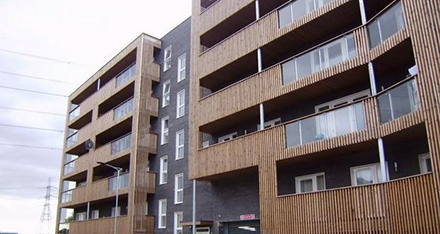
Following a number of concerns raised after a serious fire at the Samuel Garside House development in Barking in the UK recently, timber industry associations, the Timber Trade Federation (TTF) and Wood Protection Association (WPA), are clear that the failure to specify an industrial fire retardant pre-treatment for the timber balconies and cladding used on the front of the building, was completely inappropriate in the circumstances. Source: Timberbiz
The six-storey building in De Pass Gardens featured timber balconies, balcony dividers and extensive balustrading, so much so that it resembled and has been referred to as, timber cladding.
In the UK media, a fire expert called for tighter regulations in the wake of the blaze. The fire has also led to architects saying that it has caused them to rethink the use of timber.
According to the TTF and WPA, a lack of a flame retardant treatment combined with multiple small cross sections of timber with plenty of air movement around each panel, created this unnecessary fire risk.
TTF and WPA collectively agreed that treatment was essential in this situation, even though it would appear that this was not required by Building Regulations and the project was subsequently approved by Building Control.
TTF Managing Director Dave Hopkins stated that “If a comprehensive fire risk assessment had been conducted on this design it would have been clear that additional protection was required in these particular circumstances”.
It has emerged that the timber supplied for the project had a ‘Euroclass D, s2, d0’ reaction to fire rating. Flame retardant pre-treatments are readily available which could have upgraded the timber components to the more appropriate, much higher Class B rating.
If that had been done, the timber decking and cladding would have performed very differently. Such industrial flame-retardant processes are subject to independent quality assurance under a well-respected scheme operated by the WPA.
“The privatisation of Building Control services in the UK does not help in these situations. Building Control service providers are nervous about specifying standards higher than strictly required by Building Regulations (even if appropriate as was the case at Barking), in case the contractor switches to another service provider who will approve the design at the lower standard and cost. Indeed, this point was also highlighted in the Hackitt review in the aftermath of the Grenfell tragedy,” Gordon Ewbank, WPA Chief Executive said.
In conclusion, flame retardant treated wood cladding has proved fit for purpose over many years of successful service around the world and continues to meet the requirements of UK Building Regulations. If pre-treatment had been carried out in this case, the timber decking and cladding would have performed very differently.





